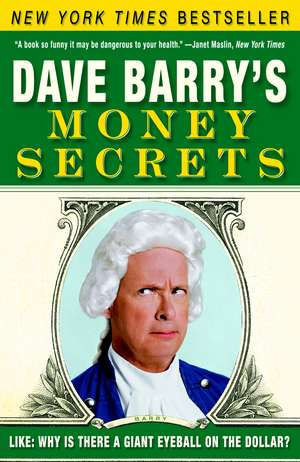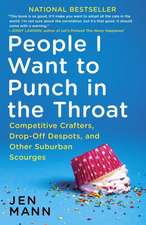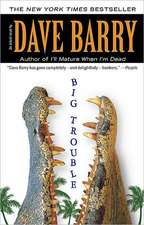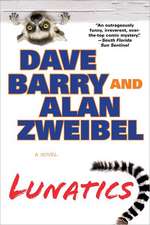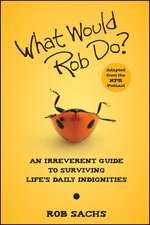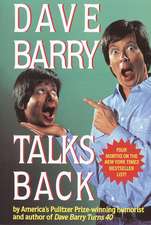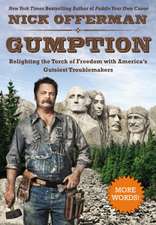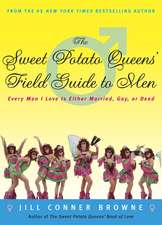Dave Barry's Money Secrets: Why Is There a Giant Eyeball on the Dollar?
Autor Dave Barryen Limba Engleză Paperback – 30 noi 2006
• How the U.S. economy works, including the often overlooked role of Adam Sandler
• Why it is not a good idea to use squirrels for money
• Strategies that will give you the confidence you need to try for a good job, even though you are—let’s be honest—a no-talent loser
• How corporate executives, simply by walking into their offices, immediately become much stupider
• An absolutely foolproof system for making money in the stock market, requiring only a little effort (and access to time travel)
• Surefire tips for buying and selling real estate, the key being: Never buy—or, for that matter, sell—real estate
• How to minimize your federal taxes, safely and legally, by cheating
• Why good colleges cost so much, and how to make sure your child does not get into one
• How to reduce the cost of your medical care by basically not getting any
• Estate planning, especially the financial benefits of an early death
• And many, many pictures of Suze Orman
But that’s only the beginning! Dave has also included in this book all of the important points from a book written by Donald Trump, so you don’t have to read it yourself. Plus he explains how to tip, how to negotiate for everything (including bridge tolls), how to argue with your spouse about money, and how much allowance to give your children (three dollars is plenty). He also presents, for the first time in print anywhere, the Car Dealership Code of Ethics (“Ethic Seven: The customer is an idiot”). Also, there are many gratuitous references to Angelina Jolie naked. You can’t afford not to buy this book! Probably you need several copies.
What kind of financial shape are you in right now? This scientific quiz will show you.
Be honest in your answers: If you lie, you’ll only be lying to yourself! The place to lie is on your federal tax return.
What is your annual income?
1. More than $50,000.
2. Less than $50,000.
3. However much I get when I return these empties.
Not counting your mortgage, how much money do you currently owe?
1. Less than $10,000.
2. More than $10,000.
3. Men are threatening to cut off my thumbs.
How would you describe your portfolio?
1. Conservative, mainly bonds and blue-chip equities.
2. Aggressive, mainly options and speculative stocks.
3. My what?
When analyzing an investment, what do you consider to be the most important factor?
1. The amount of return.
2. The degree of risk.
3. The name of the jockey.
How do you plan to finance your retirement?
1. Savings.
2. Social security.
3. Sale of kidneys.
—from the Introduction: “Why You Need This Book”
Also available as a Crown eBook.
From the Hardcover edition.
Preț: 114.47 lei
Nou
Puncte Express: 172
Preț estimativ în valută:
21.90€ • 22.93$ • 18.12£
21.90€ • 22.93$ • 18.12£
Carte disponibilă
Livrare economică 15-29 martie
Preluare comenzi: 021 569.72.76
Specificații
ISBN-13: 9780307351005
ISBN-10: 0307351009
Pagini: 230
Ilustrații: 100 B&W PHOTOGRAPHS
Dimensiuni: 134 x 203 x 13 mm
Greutate: 0.18 kg
Editura: Three Rivers Press (CA)
ISBN-10: 0307351009
Pagini: 230
Ilustrații: 100 B&W PHOTOGRAPHS
Dimensiuni: 134 x 203 x 13 mm
Greutate: 0.18 kg
Editura: Three Rivers Press (CA)
Notă biografică
Dave Barry has been awarded the Pulitzer Prize for commentary. His columns for the Miami Herald were syndicated worldwide, and he is the author of a number of bestselling books, including the recently published Peter and the Starcatchers with Ridley Pearson. He lives in Miami, where he drives very nervously.
From the Hardcover edition.
From the Hardcover edition.
Extras
Chapter 1
How Money Works
Or: Everybody Clap for Tinker Bell!
Why is money valuable? Why are people willing to work so hard for it, lie for it, cheat for it, go to prison for it, fight for it, kill for it, give up their children for it . . . even marry Donald Trump for it?
I mean, look at the dollar bill. What is it, really? It’s a piece of paper! What’s more, it’s a piece of paper that appears to have been designed by a disturbed individual. On one side, you have a portrait of George Washington, who, granted, was the Father of Our Country and a great leader and everything, but who looks, in this particular picture . . .
. . . like a man having his prostate examined by Roto-Rooter. And then on the other side of the dollar you have:
What is that about? Why is there a picture of a pyramid, instead of a structure traditionally associated with the fundamental values of the United States of America, such as a Wal-Mart? And why is the pyramid being hovered over by an eyeball the size of a UPS truck?
Whatever the explanation, the design of the dollar would not seem to inspire confidence in its value. And yet if you drop a few dollars from an overpass onto a busy freeway at rush hour, people will run into traffic and literally risk their lives in an effort to grab them. Try it!
What does this tell us? It tells us that people are stupid. But it also tells us that money is more than just pieces of paper. But what makes it valuable? To answer that question, we need to consider:
The History of Money
In prehistoric times, there was no such thing as money. When people needed to buy something, they had to charge it. And then when the bills came, nobody could understand them, because there was also no such thing as reading. This led to a lot of misunderstandings and hitting with rocks.
The first form of money that we are aware of by looking it up on the Internet was animals. From the start there were problems with this type of money, particularly the smaller denominations, such as squirrels, which were always biting the payee and scampering away.
By 9000 b.c., the most commonly accepted form of animal money was cattle. When you bought something, you would give the other person a cow, and the other person would give your change in calves. This was better than squirrels, but still not an efficient system. The cash registers were disgusting.
By 3000 b.c., the Mesopotamians had invented two concepts that revolutionized economic activity: (1) writing and (2) banking. This meant that, for the first time, it was possible for a Mesopotamian to walk into a bank and hand the teller a stone tablet stating:
GIVE ME ALL YOUR COWS AND NOBODY GETS HURT
These robbers were captured quickly, because they had to make their getaways at very slow speeds. Still, it was clear that a better medium of exchange was needed.
The ancient Chinese tried to solve the problem by using seashells as money. The advantage of this system was that seashells were small, durable, clean, and easy to carry. The drawback was that they were, in a word, seashells. This meant that anybody with access to the sea could get them. By the time the ancient Chinese had figured this out, much of their country was the legal property of gulls.
And so the quest continued for a better form of money. Various cultures experimented with a number of commodities, including tea, grains, leather, tobacco, and Pokémon cards. Then, finally, humanity hit upon a medium of exchange that had no disadvantages—a medium that was durable, portable, beautiful, and universally recognized to have lasting value. That medium, of course, was beer.
No, seriously, it was precious metals, especially gold and silver, which—in addition to being rare and beautiful—could be easily shaped into little disks that fit into vending machines.
Before long, many cultures were using some form of gold for money. It came in a wide variety of shapes and designs, as we see in these photographs of ancient coins unearthed by archeologists:
The problem was that gold is too heavy to be constantly lugged around. So, to make it easier for everybody, governments began to issue pieces of paper to represent gold. The deal was, whenever you wanted, you could redeem the paper for gold. The government was just holding your gold for you. But it was YOUR gold! You could get it anytime! That was the sacred promise that the government made to the people. That’s why the people trusted paper money. And that’s why, to this very day, if you—an ordinary citizen—go to Fort Knox and ask to exchange your U.S. dollars for gold, you will be used as a human chew toy by large federal dogs.
Because the government changed the deal. We don’t have the gold standard anymore. Nobody does. Over the years, all the governments in the world, having discovered that gold is, like, rare, decided that it would be more convenient to back their money with something that is easier to come by, namely: nothing. So even though the U.S. government still allegedly holds tons of gold in “reserve,” you can no longer exchange your dollars for it. You can’t even see it, because visitors are not allowed. For all you know, Fort Knox is filled with Cheez Whiz.
Which brings us back to the original question: If our money really is just pieces of paper, backed by nothing, why is it valuable? The answer is: Because we all believe it’s valuable.
Really, that’s pretty much it. Remember the part in Peter Pan where we clap to prove that we believe in fairies, and we save Tinker Bell? That’s our monetary system! It’s the Tinker Bell System! We see everybody else running around after these pieces of paper, and we figure, Hey, these pieces of paper must be valuable. That’s why if you exchanged your house for, say, a pile of acorns, everybody would think you’re insane; whereas if you exchange your house for a pile of dollars, everybody thinks you’re rational, because you get . . . pieces of paper! The special kind, with the big hovering eyeball!
And you laughed at the ancient Chinese, with the seashells.
So what does all this mean? Does it mean that our monetary system is a giant house of cards that would collapse like, well, a giant house of cards if the public stopped believing in the pieces of paper? Could all of our “wealth”—our savings, our investments, our pension plans, etc.—suddenly become worthless, meaning that the only truly “wealthy” people would be the survivalist wing nuts who trade all their money for guns and beef jerky?
Yes. But that probably won’t happen. Because, fortunately, the public prefers not to think about economics. Most people are unable to understand their own telephone bills, let alone the U.S. monetary system. And as long as we don’t question the big eyeball, Tinker Bell is safe.
OK, now you know what money actually is. (Don’t tell anybody!) The next question is: How come some people have so much money, while others have so little? Why does the money distribution seem so unfair? Why, for example, are professional athletes paid tens of millions of dollars a year for playing silly games with balls, while productive, hardworking people with infinitely more value to society, such as humor writers, must struggle to make barely half that? And above all, how can you, personally, get more money?
We’ll address these questions in future chapters,3 which will be chock-full of sure-fire, can’t-miss, no-nonsense, common-sense, easy-to-apply, on-the-money hyphenated phrases. You’ll be on your way to riches in no time! All you have to do is really believe in yourself! Come on, show that you really believe! Clap your hands!
Also, just in case, you should get some jerky.
Why Does the Back of the Dollar Have a Pyramid and a Giant Eyeball?
There is actually a simple explanation for these two seemingly odd symbols:
Back when the Founding Fathers were designing our currency, they were looking for an image for the new nation, an image that would symbolize the concept of something strong and massive being watched over by something all-seeing and wise. After much discussion, what they came up with—as you have probably guessed—was a picture of an owl standing on an elephant.
The Founding Fathers passed this idea along to the artist hired to do the engraving of the printing plates for the dollar, whose name was Phil. As it happened, the day he did the dollar, which was his birthday, Phil consumed what historians now believe was at least two quarts of whiskey, and for whatever reason—the only explanation he ever gave was “the squirrels made me”—he engraved a pyramid with a giant eyeball on top of it. Unfortunately, the Founding Fathers, who were in a hurry to get the dollar printed so they could spend it, failed to notice this until it was too late. Fortunately, however, they did catch the error on the front of the dollar, where, instead of George Washington, Phil had engraved a fish playing tennis. Otherwise we might live in a very different nation today.
From the Hardcover edition.
How Money Works
Or: Everybody Clap for Tinker Bell!
Why is money valuable? Why are people willing to work so hard for it, lie for it, cheat for it, go to prison for it, fight for it, kill for it, give up their children for it . . . even marry Donald Trump for it?
I mean, look at the dollar bill. What is it, really? It’s a piece of paper! What’s more, it’s a piece of paper that appears to have been designed by a disturbed individual. On one side, you have a portrait of George Washington, who, granted, was the Father of Our Country and a great leader and everything, but who looks, in this particular picture . . .
. . . like a man having his prostate examined by Roto-Rooter. And then on the other side of the dollar you have:
What is that about? Why is there a picture of a pyramid, instead of a structure traditionally associated with the fundamental values of the United States of America, such as a Wal-Mart? And why is the pyramid being hovered over by an eyeball the size of a UPS truck?
Whatever the explanation, the design of the dollar would not seem to inspire confidence in its value. And yet if you drop a few dollars from an overpass onto a busy freeway at rush hour, people will run into traffic and literally risk their lives in an effort to grab them. Try it!
What does this tell us? It tells us that people are stupid. But it also tells us that money is more than just pieces of paper. But what makes it valuable? To answer that question, we need to consider:
The History of Money
In prehistoric times, there was no such thing as money. When people needed to buy something, they had to charge it. And then when the bills came, nobody could understand them, because there was also no such thing as reading. This led to a lot of misunderstandings and hitting with rocks.
The first form of money that we are aware of by looking it up on the Internet was animals. From the start there were problems with this type of money, particularly the smaller denominations, such as squirrels, which were always biting the payee and scampering away.
By 9000 b.c., the most commonly accepted form of animal money was cattle. When you bought something, you would give the other person a cow, and the other person would give your change in calves. This was better than squirrels, but still not an efficient system. The cash registers were disgusting.
By 3000 b.c., the Mesopotamians had invented two concepts that revolutionized economic activity: (1) writing and (2) banking. This meant that, for the first time, it was possible for a Mesopotamian to walk into a bank and hand the teller a stone tablet stating:
GIVE ME ALL YOUR COWS AND NOBODY GETS HURT
These robbers were captured quickly, because they had to make their getaways at very slow speeds. Still, it was clear that a better medium of exchange was needed.
The ancient Chinese tried to solve the problem by using seashells as money. The advantage of this system was that seashells were small, durable, clean, and easy to carry. The drawback was that they were, in a word, seashells. This meant that anybody with access to the sea could get them. By the time the ancient Chinese had figured this out, much of their country was the legal property of gulls.
And so the quest continued for a better form of money. Various cultures experimented with a number of commodities, including tea, grains, leather, tobacco, and Pokémon cards. Then, finally, humanity hit upon a medium of exchange that had no disadvantages—a medium that was durable, portable, beautiful, and universally recognized to have lasting value. That medium, of course, was beer.
No, seriously, it was precious metals, especially gold and silver, which—in addition to being rare and beautiful—could be easily shaped into little disks that fit into vending machines.
Before long, many cultures were using some form of gold for money. It came in a wide variety of shapes and designs, as we see in these photographs of ancient coins unearthed by archeologists:
The problem was that gold is too heavy to be constantly lugged around. So, to make it easier for everybody, governments began to issue pieces of paper to represent gold. The deal was, whenever you wanted, you could redeem the paper for gold. The government was just holding your gold for you. But it was YOUR gold! You could get it anytime! That was the sacred promise that the government made to the people. That’s why the people trusted paper money. And that’s why, to this very day, if you—an ordinary citizen—go to Fort Knox and ask to exchange your U.S. dollars for gold, you will be used as a human chew toy by large federal dogs.
Because the government changed the deal. We don’t have the gold standard anymore. Nobody does. Over the years, all the governments in the world, having discovered that gold is, like, rare, decided that it would be more convenient to back their money with something that is easier to come by, namely: nothing. So even though the U.S. government still allegedly holds tons of gold in “reserve,” you can no longer exchange your dollars for it. You can’t even see it, because visitors are not allowed. For all you know, Fort Knox is filled with Cheez Whiz.
Which brings us back to the original question: If our money really is just pieces of paper, backed by nothing, why is it valuable? The answer is: Because we all believe it’s valuable.
Really, that’s pretty much it. Remember the part in Peter Pan where we clap to prove that we believe in fairies, and we save Tinker Bell? That’s our monetary system! It’s the Tinker Bell System! We see everybody else running around after these pieces of paper, and we figure, Hey, these pieces of paper must be valuable. That’s why if you exchanged your house for, say, a pile of acorns, everybody would think you’re insane; whereas if you exchange your house for a pile of dollars, everybody thinks you’re rational, because you get . . . pieces of paper! The special kind, with the big hovering eyeball!
And you laughed at the ancient Chinese, with the seashells.
So what does all this mean? Does it mean that our monetary system is a giant house of cards that would collapse like, well, a giant house of cards if the public stopped believing in the pieces of paper? Could all of our “wealth”—our savings, our investments, our pension plans, etc.—suddenly become worthless, meaning that the only truly “wealthy” people would be the survivalist wing nuts who trade all their money for guns and beef jerky?
Yes. But that probably won’t happen. Because, fortunately, the public prefers not to think about economics. Most people are unable to understand their own telephone bills, let alone the U.S. monetary system. And as long as we don’t question the big eyeball, Tinker Bell is safe.
OK, now you know what money actually is. (Don’t tell anybody!) The next question is: How come some people have so much money, while others have so little? Why does the money distribution seem so unfair? Why, for example, are professional athletes paid tens of millions of dollars a year for playing silly games with balls, while productive, hardworking people with infinitely more value to society, such as humor writers, must struggle to make barely half that? And above all, how can you, personally, get more money?
We’ll address these questions in future chapters,3 which will be chock-full of sure-fire, can’t-miss, no-nonsense, common-sense, easy-to-apply, on-the-money hyphenated phrases. You’ll be on your way to riches in no time! All you have to do is really believe in yourself! Come on, show that you really believe! Clap your hands!
Also, just in case, you should get some jerky.
Why Does the Back of the Dollar Have a Pyramid and a Giant Eyeball?
There is actually a simple explanation for these two seemingly odd symbols:
Back when the Founding Fathers were designing our currency, they were looking for an image for the new nation, an image that would symbolize the concept of something strong and massive being watched over by something all-seeing and wise. After much discussion, what they came up with—as you have probably guessed—was a picture of an owl standing on an elephant.
The Founding Fathers passed this idea along to the artist hired to do the engraving of the printing plates for the dollar, whose name was Phil. As it happened, the day he did the dollar, which was his birthday, Phil consumed what historians now believe was at least two quarts of whiskey, and for whatever reason—the only explanation he ever gave was “the squirrels made me”—he engraved a pyramid with a giant eyeball on top of it. Unfortunately, the Founding Fathers, who were in a hurry to get the dollar printed so they could spend it, failed to notice this until it was too late. Fortunately, however, they did catch the error on the front of the dollar, where, instead of George Washington, Phil had engraved a fish playing tennis. Otherwise we might live in a very different nation today.
From the Hardcover edition.
Recenzii
"A book so funny it may be dangerous to your health."
– Janet Maslin, New York Times
“Read this book. It will make you laugh.”
—Washington Post
From the Hardcover edition.
– Janet Maslin, New York Times
“Read this book. It will make you laugh.”
—Washington Post
From the Hardcover edition.
